E-Archive
Articles
in Vol. 24 - May Issue - Year 2023
Perfect Pre-Treatment for Agricultural Machinery
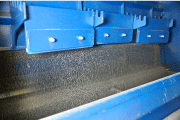
View into the wind sifting
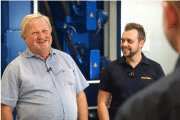
From left to right: Mr Göweil (CEO) and Mr Kapfer (project manager) in front of the AGTOS shot blast plant

Perfectly blasted surface
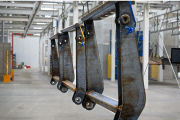
Workpieces before the blasting process
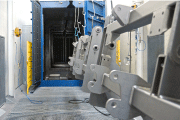
Workpieces after the blasting process
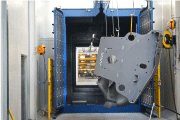
Large workpiece after the blasting process
Since 1988, GÖWEIL has epitomized excellence in the area of baling and wrapping technologies thanks to a product selection of unsurpassed quality. Other core areas of the company’s activities include bale opening and transport devices, high-lift buckets and blade sharpeners.
Through the extremely high export share, GÖWEIL’s machines are not just known in Europe, but rather they are known and used worldwide. Originally, the company specialized in the production of agricultural machines, now there are also several machines available for industrial use. Thus, the number of employees grew to more than 300 and the turnover increased to about € 50 million.
As a unique selling proposition, the products are supplied exclusively for the professional sector, mainly to contractors. The demands on the machines are correspondingly high, which also applies to the surfaces. Customer support is optimally organized by the company’s own service centers in 24/7 mode and thus forms a further aspect of performance.
New surface and assembly center on the greenfield site
The surfaces of agricultural machinery are exposed to heavy mechanical stress. Therefore, a coating with good adhesion is required. In addition to the protective function, the coating also has the task of presenting the value of the machine in a visually appealing way. This was recognized at GÖWEIL and implemented accordingly.
At the beginning of 2022, a new surface and assembly center in Rainbach im Mühlkreis, Austria, was put into operation, covering a floor space of approximately 16,600m². Since then, the preliminary products from the company’s own plant in nearby Kirchschlag as well as from other suppliers have been processed and finished here. Herbert Göweil is pleased with the new production facility: “We are very satisfied with the investment. All expectations have been fulfilled. In the original paint shop in Kirchschlag, the plant was prone to breakdowns, and large parts had to be blasted by hand, which was of course very time-consuming.”
Many plans and suggestions from visits by the GÖWEIL project team to similar production tasks in other industries formed the basis for the planning. Thus, the decision for wet painting instead of powder painting was also quickly made. Because the wet painting would have been necessary in any case for some parts from the wide range of GÖWEIL. Incidentally, an automatic color change was made possible for the three standard colors: blue, yellow and black.
Now, the first experiences and results of the new operation are available. More than 1,000 parts are needed for GÖWEIL’s products and 90 % of them have to be blasted in preparation for the subsequent wet painting. The parts are cleaned of scale after welding.
The investment sum for the entire complex was over € 27 million and thus sets an example in this region. The planning was started backwards according to the production process. The area was determined on the basis of the expected assembly capacity.
The painting system from the manufacturer RIPPERT and the upstream wet-chemical pre-treatment, the double rinsing process with adhesive water dryer and also the AGTOS blasting technology were calculated on the basis of these capacities, too. The treatment processes, which also include masking, were connected by a friction wheel conveyor system from the manufacturer KJ. Like this, it is possible to produce not only according to the “first-in-first-out” principle. The system makes it possible to determine a modified sequence, and this connects all the way to the assembly line.
The respective processing recipes are defined and filed by the production planning. Each product carrier has a data medium on which the specific processing parameters are stored.
A second painting line has been planned for future growth. GÖWEIL is considering using a robot painting system here to process standard parts.
Interesting details on the shot blasting technology
The blasting tasks are performed by an AGTOS continuous overhead conveyor blast machine of type DHT 25-25. Various work pieces are suspended from cross beams with a length of 7,000mm. The blast chamber of the machine can hold work piece dimensions of W × H max. 2,500 × 2,500 mm. The maximum work piece weight is 2,000kg.
Due to the quite different and angled geometries of the work pieces, the system was equipped with 16 high-performance turbines with 11.0kW each. Frequency converters allow the best setting of diverse processing programs. Round and angular grain can be used as blasting media. The throughput speed is approximately 1 to 3m/min.
The abrasive is recirculated and fed back to the turbines after cleaning. Two AGTOS cartridge filter systems of type PF 4-40 ensure a residual dust content of
The work pieces are blown off after the blasting process and thus freed from dust and remaining blasting media, which ensures that they are optimally cleaned before they are painted.
Mathias Kapfer, Project Manager of the new plant, summarizes the differences compared to the previous state as follows: “Today, about 90 % of the process is automated. That means that we hang the parts on the system, they pass through the shot blast plant fully automatically via the conveyor system. The recipes are assigned directly to the product carrier, so there is no manual manipulation or anything like that. The expectations and the challenges were great. It was the right decision that we did it with AGTOS. The biggest advantage is that we get our largest component through the machine, something that was not possible before because the large base frames were blasted by hand.”
The issue of conserving resources is also rated positively. Kapfer says “Especially, the throughput time is enormous with this plant. If we think back to the operation in Kirchschlag, we need about three quarters of an hour for a large base frame by hand. Here, with automatic blasting, we need about 10 minutes. So the shot blast plant and also that has changed very positively.”
For Information: AGTOS
Gesellschaft für technische
Oberf lächensysteme mbH
Gutenbergstr. 14, 48282 Emsdetten
Germany
Tel. +49.2572.96026-0
E-mail: info@agtos.de, www.agtos.de




























